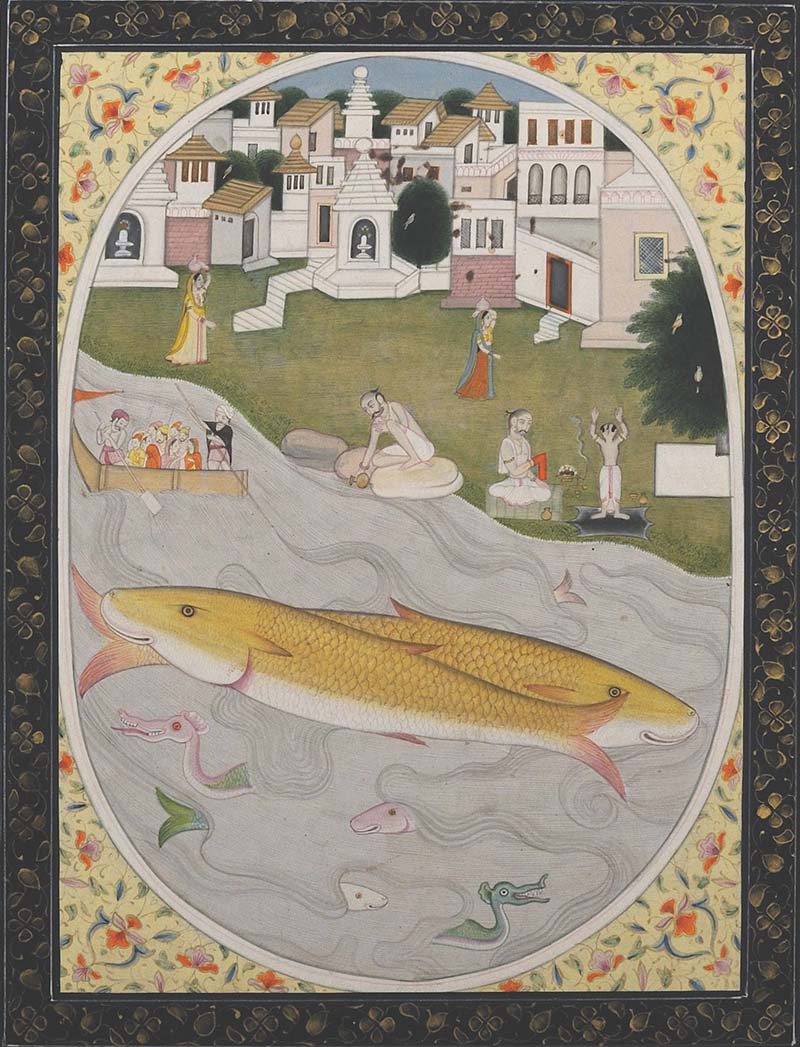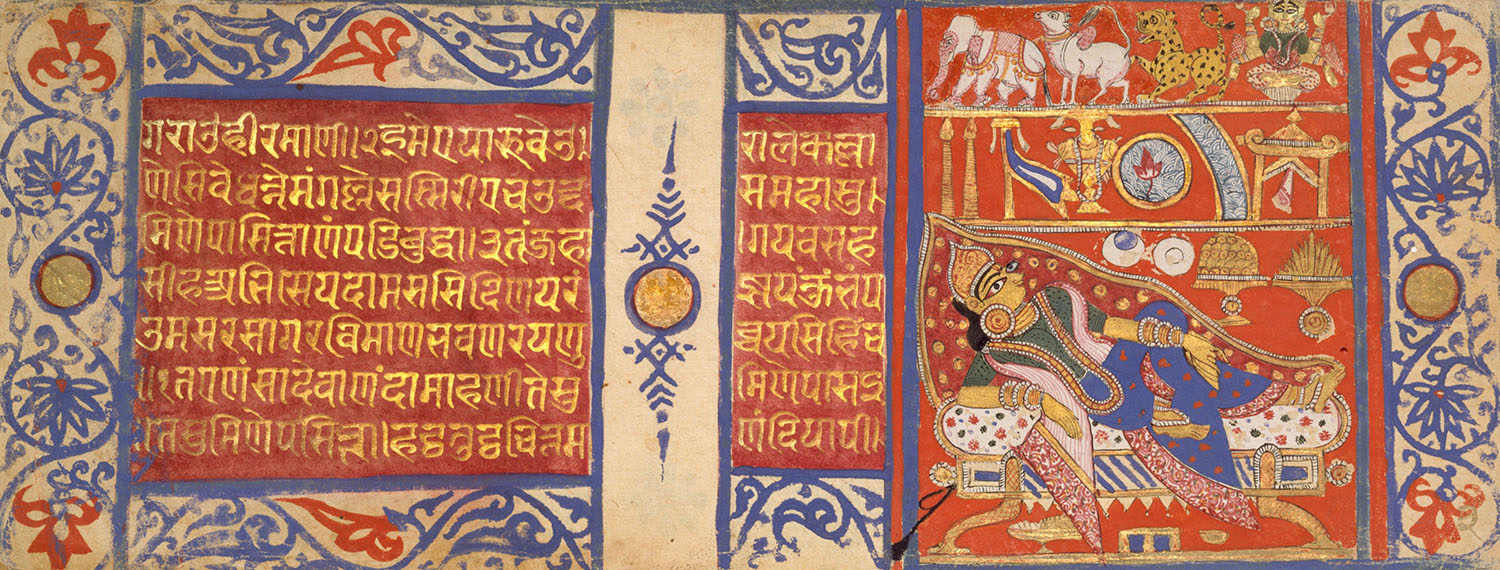ARTICLE
Manuscript and Miniature Painting in South Asia
While some scholars date South Asian manuscript painting traditions to as far back as the third or fourth century CE, among the earliest surviving evidence of these is a wooden cover panel found from Gilgit in present-day Kashmir, dating back to the ninth century. Its cover image indicates a Buddhist manuscript, and it would have contained palm-leaf folios like those that survive of the eleventh-century manuscripts made at the Pala-patronised monastic centres of Nalanda and Kurkihar in present-day Bihar. Such Buddhist texts, along with Jain religious texts, constituted the most commonly illustrated manuscripts in India before the establishment of Islamic sultanates in the subcontinent. Restricted by the dimensions of the palm leaves used, these were narrow rectangular manuscripts, which were bound horizontally. While the advent of paper in the twelfth century allowed for different dimensions, the earliest paper manuscripts too retained a similar format, with illustrations usually no larger than 5 to 8 centimetres square. These manuscripts were typically dominated by the text, with the images playing a largely decorative or iconic role. In later traditions, however, both text and image were crafted and patronised to an equal degree.
By the fourteenth century Indian manuscripts began absorbing influences from the arts of Safavid Persia, through the Sultanate courts, and later the Mughal empire. Indian courts commissioned manuscripts, or codices, made in different sizes and more closely resembling the form of the modern book. Paper, which was now used for these manuscripts, also allowed for a variety of pigments and mediums for painting. These patrons commissioned lavish manuscripts, often employing highly skilled artisans and using rare or precious materials as pigment, including gold and lapis lazuli. Intricacy of workmanship was also achieved through specialised tools such as fine squirrel hair brushes, sometimes comprising a single strand. Today the quality of workmanship and materials observed on extant manuscripts — intricacy of border patterns, neatness of composition and use of expensive colours such as gold and ultramarine blue — also serve to distinguish those that were produced under the patronage of wealthy courts and aesthetically inclined rulers, compared with those made in imitation by smaller courts.
Beginning with the Mughal emperor Akbar’s (r. 1556–1605) patronage of the art form in the second half of the sixteenth century, Mughal manuscripts became the most influential style in India. The Mughal atelier, originally led by Persian artists, attracted painters and calligraphers from across regions and cultural backgrounds. Mughal painters were also exposed to Christian prints through European visitors to the court, and adopted some attributes of Western Renaissance art, most notably a naturalism of forms and the aerial perspective. Around this time, the Deccan kingdoms that had broken away from the Bahmani Sultanate in the sixteenth century began commissioning illustrated manuscripts of their own, first in a highly original, elaborate aesthetic and then in a more noticeably Mughal style. Manuscript painting traditions that were directly or indirectly influenced by the Persian style typically have a lighter colour palette, a high horizon line and tend towards naturalism in the rendering of faces, flora and fauna — all notable features of Mughal manuscript paintings.
Although some kingdoms in present-day Rajasthan also began patronising manuscript painters around the same time as the Mughal court, the Rajput style emerged in earnest only by the late seventeenth century, as painters left the declining ateliers of the Mughal court and moved to Rajput kingdoms in Rajasthan, and in the Himalayan foothills in present-day Himachal Pradesh where Pahari painting emerged as a distinct school. A number of other miniature painting traditions flourished in India, including Majuli manuscript painting, Bengal Sultanate manuscript painting and Awadhi manuscript painting.
Besides these various individual manuscripts, including a Jain-style Shahnama, the Nimatnama-i-Nasiruddin-Shahi cookbook and an illustrated copy of the Chandayana, have been influential and significant in Indian art history. Apart from imperial patronage, wealthy merchants or noblemen also commissioned manuscripts, although these are more difficult to date and were executed by minor or inexperienced artists. Exceptions to this include the few European patrons who were active in the eighteenth and nineteenth centuries, though they typically commissioned muraqqas.
By the late nineteenth century, rulers of the princely states under British rule favoured photography and large Western-style portraiture as mediums of courtly imagery, leading to the decline of illustrated manuscript painting. While illustrated manuscripts are no longer produced, the most recognisable styles of such painting have been adopted by several contemporary artists from Pakistan, most notably Shazia Sikander, Bashir Ahmad, Saira Wasim and Imran Quereshi. In India, miniature painting has also been a major influence on the artists of the Baroda school and Bengali Modernists such as Nilima Sheikh and Abanindranath Tagore.
Bibliography
Di Pietrantonio, Natalia. “Desiring Landscapes: Two Paintings from Avadh, India.” The Metropolitan Museum of Art, August 25, 2015. https://www.metmuseum.org/blogs/ruminations/2015/desiring-landscapes.
Encyclopaedia Britannica. “Pala Art.” Accessed December 10, 2021. https://www.britannica.com/topic/Pala-art.
Government of Assam. “Manuscript Writing.” Accessed December 14, 2021. https://majuli.gov.in/portlet-innerpage/manuscript-writing.
Guy, John, and Jorrit Britschgi. Wonder of the Age: Master Painters of India, 1100–1900. New York: Metropolitan Museum of Art, 2011.
Kapadia, Aparna. “Why a 15th-century manuscript of Indian recipes lists eight kinds of samosas – none with potatoes.” Scroll, September 9, 2019. https://scroll.in/article/936159/why-a-15th-century-manuscript-of-indian-recipes-lists-eight-kinds-of-samosas-none-with-potatoes.
Kossak, Steven. Indian Court Painting: 16th–19th Century. New York: The Metropolitan Museum ofArt, 1997.
Qureshi, Bilal. “Breaking The Mold: Artist’s Modern Miniatures Remix Islamic Art.” NPR, October 02, 2015. https://www.npr.org/2015/10/02/445291163/breaking-the-mold-artists-modern-miniatures-remix-islamic-art.
Shovelton, Emily. “Revisiting a Royal Sultanate Manuscript from Bengal: The Sharafnama of Nasir Al-Din Nusrat Shah of 938/1531–2.” Iran 59, no. 2 (2021): 225–44. https://www.tandfonline.com/doi/full/10.1080/05786967.2021.1911759?scroll=top&needAccess=true.
The Metropolitan Museum of Art. “”Laur and Chanda in the Forest”, Folio from a Chandayana (or Laur Chanda).” Accessed December 14, 2021. https://www.metmuseum.org/art/collection/search/453192.
The Metropolitan Museum of Art. “Gushtasp Slays the Dragon: Page from a Shahnama Manuscript.” Accessed December 14, 2021. https://www.metmuseum.org/art/collection/search/76042.
Victoria and Albert Museum. “Jainism: Illuminated Manuscripts and Jain Art.” September 21, 2015. http://www.vam.ac.uk/content/articles/j/jainism_illuminated_manuscripts-and-jain-paintings/.








